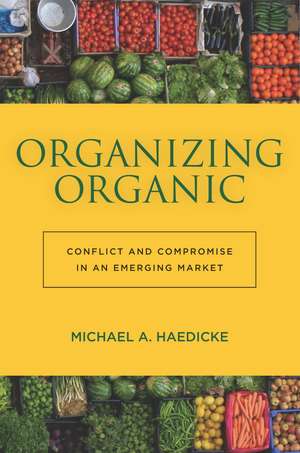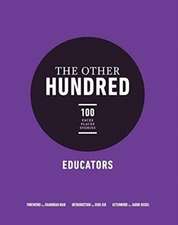Organizing Organic: Conflict and Compromise in an Emerging Market
Autor Michael Haedickeen Limba Engleză Hardback – 17 mai 2016
Tracing the history of the organic food sector, Michael A. Haedicke charts the development of two narratives that do more than simply polarize the organic debate, they give way to competing institutional logics. On the one hand, social activists contend that organics can break up the concentration of power that rests in the hands of a big, traditional agribusiness. Alternatively, professionals who are steeped in the culture of business emphasize the potential for market growth, for fostering better behemoths. Independent food store owners are then left to reconcile these ideas as they construct their professional identities and hone their business strategies.
Drawing on extensive interviews and unique archival sources, Haedicke looks at how these groups make sense of their everyday work. He pays particular attention to instances in which individuals overcome the conflicting narratives of industry transformation and market expansion by creating new cultural concepts and organizational forms. At once an account of the sector's development and an analysis of individual choices within it, Organizing Organic provides a nuanced account of the way the organic movement continues to negotiate ethical values and economic productivity.
Preț: 475.02 lei
Preț vechi: 586.45 lei
-19% Nou
90.89€ • 99.04$ • 76.59£
Carte tipărită la comandă
Livrare economică 23 aprilie-07 mai
Specificații
ISBN-10: 0804795908
Pagini: 240
Dimensiuni: 152 x 229 x 18 mm
Greutate: 0.48 kg
Editura: Stanford University Press
Colecția Stanford University Press
Recenzii
Notă biografică
Cuprins
This chapter introduces the transformative and expansionary logics that exist in the organic sector, using both illustrative vignettes and formal exposition, and explains the book's twin goals of (1) understanding the development of these logics during the sector's history and (2) examining the relationship between these logics and the activities of sector participants. It locates this project in the context of scholarship about institutional logics and discusses the book's relationship to other literature about organic farming and the organic movement. It also explains how the concepts of interpretive framing and organizational/institutional work provide insight into links between contradictory logics and social processes of conflict and compromise. Finally, the chapter provides a summary of key arguments and a plan of the book as a whole.
This chapter examines the origins of the transformative and expansionary logics in the organic sector and makes the argument that ideas and practices related to both market expansion and sociocultural change were present during the sector's early years. It discusses a number of cultural influences that shaped organic farming between approximately 1945 and 1975, including advocacy for alternative agriculture and natural foods, the 1960s counterculture and ecology movements, and mainstream understandings of efficient market organization. The chapter also contends that widespread conflict did not occur, despite the existence of divergent cultural understandings, for two reasons: (1) the organic sector's decentralized character and (2) the tendency of advocates to downplay tensions between the divergent understandings. These arguments are supported by examinations of farmers' groups and retailing arrangements and by analysis of the work of the organic advocate J.I. Rodale and other writers in the magazine Organic Gardening and Farming.
This chapter discusses the passage of the Organic Foods Production Act (OFPA) of 1990 and the subsequent development of the National Organic Program (NOP), which established federal rules for the organic trade. It argues that OFPA and the NOP sparked conflict in the organic sector by prioritizing market growth and by marginalizing transformative ideas and practices. The chapter explains how problems associated with the expanding organic trade and a disruptive food scare created the conditions for OFPA's passage. It also examines how sector members worked at the legislative and institutional levels to bring democratic arrangements associated with the transformative logic into the regulations. These efforts resulted in a stakeholder advisory group known as the National Organic Standards Board (NOSB), but they did not prevent dissident organic foods farmers and consumers from mobilizing around frames that questioned the legitimacy of the federal regulations.
The finalization of the National Organic Program (NOP) accelerated the growth of the organic market. This chapter unpacks related changes that have occurred in the post-NOP period. First, it describes the erosion of economic and organizational partitions between the organic foods sector and the mainstream food industry through a process that is labeled convergence, paying special attention to organic foods retailing. It then argues that newly arrived sector members have transposed cultural schemas from the mainstream business world to organize their work in the organic sector. This has elaborated expansionary understandings by (1) providing a moral justification for market growth, (2) contributing to the marginalization of countercultural businesses and critical activists through boundary work, and (3) relegating consumers to the role of purchasers by encouraging their exclusion from discussions related to organic regulations.
The organic foods market's growth has fueled the efforts of activist groups who reassert transformative understandings of organic farming. This chapter discusses how activists frame market growth and convergence as a corporate takeover of the organic foods sector. It explains how this frame provides a means to link specific regulatory issues, including those related to synthetic ingredients, antibiotics, livestock management, and others to the larger issue of organic integrity. It identifies specific obstacles that activists face when they try to influence the federal organic regulations, and it also discusses how they use this frame to mobilize consumers to participate in boycott campaigns. Finally, it describes an alternative, less contentious response to market growth and convergence: the decision of some small-scale farmers to exit the sector and organize alternative certification programs that go "beyond organic."
This chapter analyzes how co-op stores, which were created as part of the 1970s counterculture, have navigated the organic sector's shift in the direction of market expansion. It argues that the history of co-cops and their position in the organic market create ambivalence about their activities and priorities, and that this ambivalence also appears in co-op leaders' assessments of the organic sector's convergence with the mainstream food industry. The chapter also documents how members of co-ops have negotiated hybrid organizational arrangements and practices that strive for compromise between the goals of market growth and systemic change. Several examples of hybrid arrangements are discussed, including (1) the unification of co-ops into a democratically run "virtual chain," (2) flexible store policies related to merchandising and product selection, and (3) education programs that encourage consumers to think reflexively about the products they buy.
This chapter reviews the book's major arguments and discusses the study's implications for understanding multi-institutional fields (in general) and the future of the organic foods sector (in particular). Four arguments regarding multi-institutional fields are advanced: (1)scholars should examine moral and emotional, as well as cognitive, aspects of logics, (2)multi-institutional fields encourage reflexive creativity, (3)identifying social mechanisms will increase knowledge about how conflict emerges (or fails to emerge) in multi-institutional fields, and (4)consumers may play a minor role in guiding the development of ethical markets. Regarding the organic sector's future, the chapter argues that the expansionary logic's dominance has yielded important gains, but that attention should be paid to revitalizing democratic arrangements and practices.









